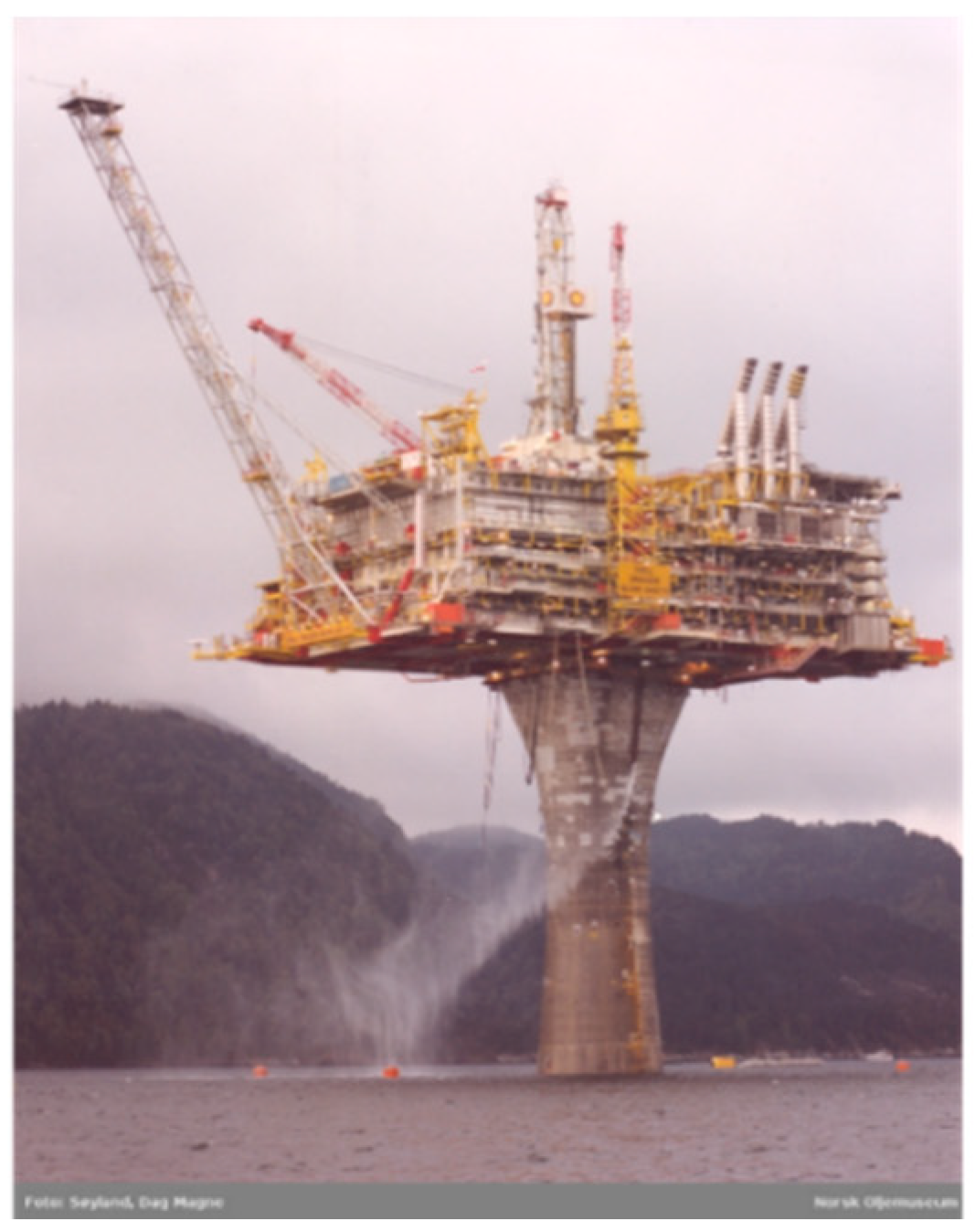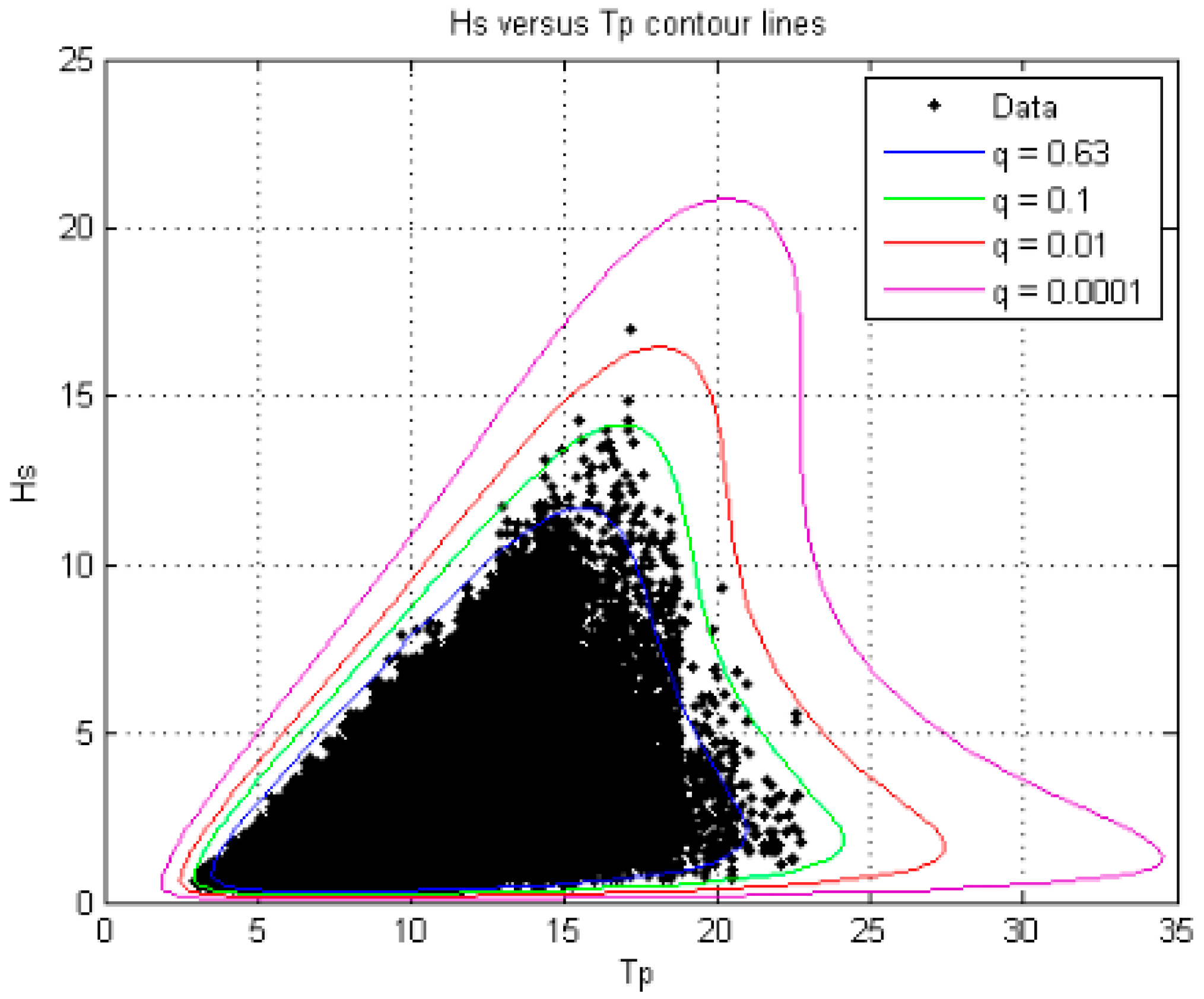Modelling of Waves for the Design of Offshore Structures
Abstract
1. Introduction
2. The Draugen Ringing Event
- Data from a MIROS radar were available from another location on the Haltenbanken area, at the Heidrun field [9]. This field, located 120 km to the north-north-west, had the platform installed in August 1994 and the field came into production in August 1995. Given a recording of a very steep wave event at this field, say with a period of 17 to 20 s, it would take an estimated 1 h to 1 h and 20 min for the wave event to reach Draugen. This would have made it possible for the Aberdeen Weather Center to reach out in time to warn the Draugen platform crew. Although the waves in February and March of 1995 in general were large, there is, however, no indication in the report [9] that there were waves with Hs higher than 10.5 m.
- A Polar Low-pressure area was approaching with a speed equal to the phase speed of waves in the Polar Low [10] causing very rapid build-up of large waves. In a Polar Low the wave heights will continue to grow with time when the “resonant motion” continues, i.e., when the phase velocity is equal to the propagation speed of the Polar Low-pressure area.
- Note that there were no wave radar nor buoy measurements at the Draugen platform until 1996.
3. Possible Explanation of the Draugen “Ringing Event”
4. Freak Wave Modelling/Rogue Waves
5. The Challenge to Model Nonlinear Waves in the Wave Tank
- Creating a model wave trace (based on observed rogue wave information), analyze its Fourier components linearly, and ensure that the Fourier components catch up with each other and interact nonlinearly at the test location in the tank.
- We could carry out a long time series experiment using linear waves whereby eventually a very large wave would appear through nonlinear wave-wave interaction, and then ensure that the captured surface profile is recreated from a sum of linear waves by Fourier analysis as suggested above.
- Alternatively, and preferably, we could create a series of steep waves selected in accordance with the environmental contour (Figure 2), which would interact nonlinearly at the test location in the wave tank.
- We could also revisit the suggestion of Professor Clauss [27] to use wavelets to capture the design action situation.
6. Conclusions
Funding
Acknowledgments
Conflicts of Interest
References
- International Standardization Organization, ISO: ISO 19902. Petroleum and Natural Gas Industries—Fixed Steel Offshore Structures; ISO: Geneva, Switzerland, 2011. [Google Scholar]
- Choi, S.J. Breaking Wave Impact Forces on an Offshore Structure. Ph.D. Thesis, University of Stavanger, Stavanger, Norway, 2014. [Google Scholar]
- Jose, J. Offshore Structures Exposed to Large Slamming Wave Loads. Ph.D. Thesis, University of Stavanger, Stavanger, Norway, 2017. [Google Scholar]
- Reyne, B. Apparent Negative Damping, an Original Approach to the Oscillations of Offshore, Structures. Master’s Thesis, University of Nantes, Nantes, France and University of Stavanger, Stavanger, Norway, 2016. [Google Scholar]
- Standards Norway. Actions and Actions Effects; Norsok Standard N003: Lysaker, Norway, 2019. [Google Scholar]
- Haver, S.; Bruserud, K.; Baarholm, G.S. Environmental Contour Method: An Approximate Method for Obtaining Characteristic Response Extremes for Design Purposes. Statoil, DNV, 2012. Available online: http://waveworkshop.org/13thWaves/Papers/Sverre%20Haver%20_%20Wave%20Hindcast%20%20Forecast%20%20Environmental%20contour%20method.pdf (accessed on 10 April 2020).
- Osborne, A.R. Breather Turbulence: Exact Spectral and Stochastic Solutions of the Nonlinear Schrödinger Equation. Fluids 2019, 4, 72. [Google Scholar] [CrossRef]
- Magnusson, A.K.; Trulsen, K.; Bitner-Gregersen, E.M.; Aarnes, O.J.; Malila, M.P. “Three sisters” measured as a triple rogue wave group. In Proceedings of the Conference OMAE 2019, Paper OMAE2019-96837, Glasgow, UK, 9–14 June 2019. [Google Scholar]
- Iden, K.; Tønnessen, H. Environmental Data Heidrun TLP, Annual Synthesis 1997, Report Number 12/98 Klima; Norwegian Meteorological Institute: Bergen, Norway, 1998. [Google Scholar]
- Orimolade, A.P.; Furevik, B.R.; Noer, G.; Gudmestad, O.T.; Samelson, R.M. Waves in polar lows. J. Geophys Res. Ocean. 2016, 121, 6470–6481. [Google Scholar] [CrossRef]
- Gudmestad, O.T. Management of Challenges during the construction of offshore facilities. Int. J. Energy Prod. Manag. 2019, 4, 187–197. [Google Scholar] [CrossRef]
- Faltinsen, O.M.; Newman, J.N.; Vinje, T. Nonlinear wave loads on a slender vertical cylinder. J. Fluid Mech. 1995, 289, 179–198. [Google Scholar] [CrossRef]
- Hellevik, K.; Gudmestad, O.T. Limit cycle oscillations at resonances for systems subjected to nonlinear damping or external forces. J. Phys. Conf. Ser. (JPCS). The open-access IOP Conference Series. 2017. Available online: https://uis.brage.unit.no/uis-xmlui/handle/11250/2498756 (accessed on 18 April 2020).
- Stansberg, C.T. Comparing simple models for prediction of ringing loads and responses. In Sintef Report 580133.00.01; 2009. [Google Scholar]
- Dysthe, K.B. Note on a modification to the nonlinear Schrödinger equation for application to deep water waves. Proc. R. Soc. A 1979, 369, 105–114. [Google Scholar]
- Trulsen, K.; Dysthe, K.B. A modified nonlinear Schrödinger equation for broader bandwidth gravity waves on deep water. Wave Motion 1996, 24, 3281–3289. [Google Scholar] [CrossRef]
- Magnusson, A.K. (Meteorologisk Institutt, Oslo, Norway). Personal communication on mail on 25th October 2019 related to the Draugen ringing event, 1995.
- Reistad, M.; Breivik, Ø.; Haakenstad, H.; Aarnes, O.J.; Furevik, B.R.; Bidlot, J.R. A high-resolution hindcast of wind and waves for the North Sea, the Norwegian Sea, and the Barents Sea. J. Geophys. Res. 2011, 116, C05019. [Google Scholar] [CrossRef]
- Lopatoukhin, L.J.; Boukhanovsky, L.V. Statistics of extreme and freak waves. In Proceedings of the OMAE2006 25th International Conference on Offshore Mechanics and Arctic Engineering (Proceedings of the Conference OMAE 2006), Hamburg, Germany, 4–9 June 2006. Paper number OMAE2006-92236. [Google Scholar]
- Haver, S. A possible freak wave event measured at the Draupner Jacket January 1 1995. In Proceedings of the Conference on Rogue Waves, Brest, France, 20–22 October 2004; Olagnon, M., Prevosto, M., Eds.; Ifremer: Brest, France, 2004. [Google Scholar]
- Sand, S.E.; Ottesen-Hansen, N.E.; Jacobsen, V.; Gudmestad, O.T.; Sterndorff, M. Freak Wave Kinematics. In Proceedings of the NATO Advanced Research Workshop, Molde, Norway, 22–25 May 1989; Tørum, A., Gudmestad, O.T., Eds.; Kluwer Academic Press: Amsterdam, The Netherlands, 1990. [Google Scholar]
- Haver, S. Evidences of the Existence of Freak Waves. In Proceedings of the Rogue Waves 2000; Ifremer: Brest, France, 2000; pp. 129–140. [Google Scholar]
- Faulkner, D.; Buckley, W.H. Critical survival conditions for ship design. In Proceedings of the RINA first International Conference on Design and Operations for Abnormal Conditions, Glasgow, UK, 21–22 October 1997; pp. 1–25. [Google Scholar]
- Osborne, A.R. Nonlinear Fourier Analysis of Ocean waves. In Proceedings of the Keynote lecture at Sintef’s Seminar “Future paths and needs in wave Modelling”, Trondheim, Norway, 21–22 October 2019. [Google Scholar]
- Bunnik, T.; Stansberg, C.T.; Pakozdi, C.; Fouques, S.; Somers, L. Useful indicators for screening of sea states for wave impacts on fixed and floating platforms. In Proceedings of the Conference OMAE 2018, Paper No. OMAE2018-78544, Madrid, Spain, 17–22 June 2018. [Google Scholar]
- van Raaij, K.; Gudmestad, O.T. Wave in deck loading on fixed steel jacket decks. Mar. Struct. 2007, 20, 164–184. [Google Scholar] [CrossRef]
- Clauss, G.; Bergmann, J. Gaussian Wave Packets—A New Approach to Seakeeping Tests of Ocean Structures. Appl. Ocean Res. 1986, 8, 190–206. [Google Scholar] [CrossRef]
- Gudmestad, O.T. Rationale for Development of Design Basis for Barents Sea field developments. In Proceedings of the IOP Conference Series: Materials Science and Engineering 2019, Stavanger, Norway, 27–29 November 2019; The open-access IOP Conference Series. Volume 700. [Google Scholar]
- Bitner-Gregersen, E.M.; Toffoli, A. Probability of occurrence of rogue sea states and consequences for design of marine structures. Ocean Dyn. 2014, 64, 1457–1468. [Google Scholar] [CrossRef]



© 2020 by the author. Licensee MDPI, Basel, Switzerland. This article is an open access article distributed under the terms and conditions of the Creative Commons Attribution (CC BY) license (http://creativecommons.org/licenses/by/4.0/).
Share and Cite
Gudmestad, O.T. Modelling of Waves for the Design of Offshore Structures. J. Mar. Sci. Eng. 2020, 8, 293. https://doi.org/10.3390/jmse8040293
Gudmestad OT. Modelling of Waves for the Design of Offshore Structures. Journal of Marine Science and Engineering. 2020; 8(4):293. https://doi.org/10.3390/jmse8040293
Chicago/Turabian StyleGudmestad, Ove Tobias. 2020. "Modelling of Waves for the Design of Offshore Structures" Journal of Marine Science and Engineering 8, no. 4: 293. https://doi.org/10.3390/jmse8040293
APA StyleGudmestad, O. T. (2020). Modelling of Waves for the Design of Offshore Structures. Journal of Marine Science and Engineering, 8(4), 293. https://doi.org/10.3390/jmse8040293




